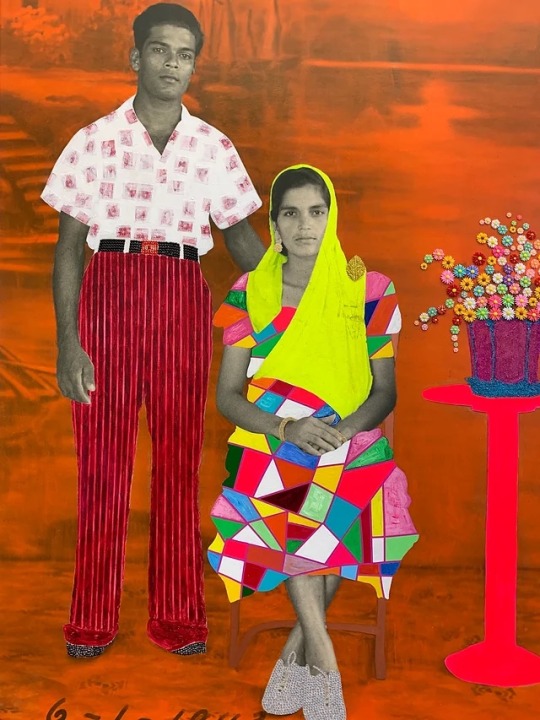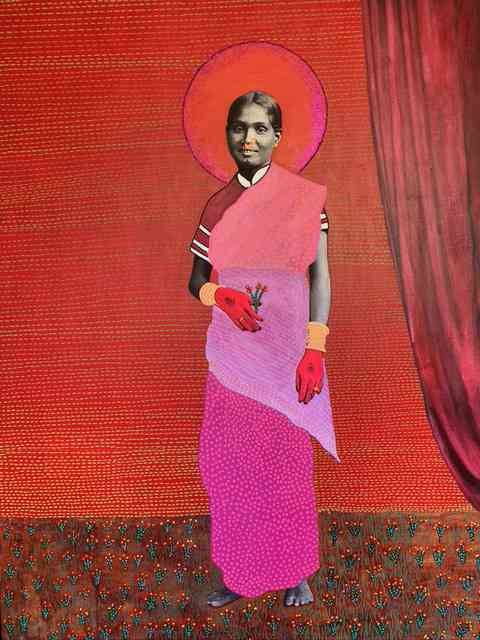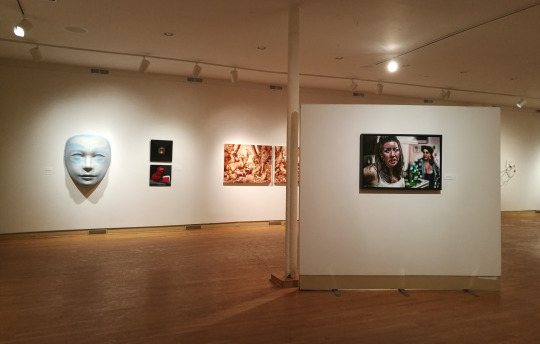#Renluka Maharaj
Text



Renluka Maharaj
« Vidya and Vashti »
Acrylic paint, acrylic markers, glitter, rhinestones, archival photo on canvas, 2020
« Wong's Studio 1943 »
Mixed Media on Archival Paper, 2019
« Susie, Sero, Bebe »
Acrylic paint, acrylic markers, acrylic gold leaves and archival photo on canvas
#Renluka Maharaj#trinidad#trinidad and tobago#indo Trinidadian#arte#art#trini art#caribbean art#caribbean artist#mixed media
15 notes
·
View notes
Link

~Sexypink~ Just in time.
#photography#Sexypink/Renluka Maharaj#Sexypink/Indian themed/colonial era work#Renluka Maharaj#Colonial era#portraits#women laborers in colonial times#mixed media#Indo-Caribbean
3 notes
·
View notes
Text

In new exhibition, Trinidadian-born Renluka Maharaj reimagines Indian indentureship in technicolor - Scroll.in http://dlvr.it/RlfktD
0 notes
Text
Catalog Essay: “The New UnNatural,” curated by Robin Dluzen & Mary Lou Zelazny at Ukrainian Institute of Modern Art

The genre of the “grotesque” is ancient, with examples from every culture and period. Ranging from the fanciful to the hideous, hybridized figurative forms have been used by artists around the world as satire, commentary, ornamentation and ritual. For the artists in “The New UnNatural,” Laurie Hogin, Amanda Elizabeth Joseph, Renluka Maharaj, Julie Potratz, Chloe Seibert, Maria Tomasula and Mary Lou Zelazny, the attraction to the modern grotesque, to rough or deformed amalgamations is both personal and political.
In embracing the unsettling, the absurd and the repulsive, the artists in this exhibition eschew the notion of the “beautiful,” not as a feminist critique of “beauty” or its representation in art; rather, the grotesque offers a means of coping with the rising anxieties and overstimulation of our times: a callus of sorts to strengthen one’s ability to withstand violence, chaos and the inescapable bombardment of stimuli. So too does the grotesque provide a vehicle for power and self-assertion, especially in the hands of women.
In Mary Lou Zelazny’s works, figures and compositions are Frankenstein-ed together, with layers of paint, collage and painted collage, resulting in works that undermine the harmony and pleasingness of what one expects from a painting and its subject matter. In Nobody’s Fault, a fallen figure is swarmed and smothered by the feminine accoutrements of organza and jewelry; in The Vaccination, fractured female bodies assail one another, entwined and armed with needles. Like Zelazny’s bodies, Laurie Hogin’s subjects occupy an unsettling grey area between the human and the inhuman. In her expertly rendered, representational paintings and prints, Hogin injects animals with very human emotions. The expressions of gluttonous monkeys, enraged rabbits and spastic birds are somehow so much more unnerving and palpable than they would be in a person, becoming powerful allegories of the worst in our nature.
So too do Chloe Seibert’s ghastly, crudely wrought faces affront us with their intensity. With gashes serving as orifices and cheap, heavy chains hanging from noses and mouths, Seibert’s sculptures are as visceral in what they depict as they are in their making process. Her Hardware Expressions bare the evidence of the artist’s hands dragged and clawed through wet plaster, while the furious marks of Mask seem like the aftermath of a maniacal fit of brushwork. Maria Tomasula and Renluka Maharaj also make masterful use of the grotesque power of the viscous. Tomasula reduces the figure to its bones and organs, arranging the pieces into painted still-lives. For her, the representation of body parts separate from the whole speaks to our connection to nature on the most basic level. In works like This is my Knowing, bare bones and a glistening heart are symmetrically arranged in a particularly feminine kind of occult tableau. So too does Maharaj engage with the grotesque through the aesthetics of ritual. In They Came for the Gold, a nude female body is covered (save for her bare throat) in thick molasses atop a bed of dried flowers. Here, Maharaj pushes these metaphorically feminine elements —the sickly sweet molasses, the dead flowers, the objectified nude— to the extreme, nowhere near beautiful, instead thoroughly macabre.
Forgoing the poetic and the dramatic, Amanda Elizabeth Joseph and Julie Potratz locate the grotesque in the more typical female experience. In Dancing with Myself, Potratz performs a bouncy, playful dance in front of a tinsel backdrop; part-way through, Potratz is joined by a floppy puppet replica of herself, puppeteered from behind the tinsel. As the “twins” dance, Potratz’ movements become more and more like the puppet’s, and the uncanniness shifts from humorous and absurd to downright creepy. Likewise for Joseph, otherwise unremarkable scenarios exploit the everyday potential for the grotesque. In the artist’s hyper-real paintings and drawings, young women in wife-beater tank tops and bare feet swill cheap beers and smoke cigarettes. In Joseph’s hands, every flaw is glaring and exaggerated, from oily skin to gaping pores, and peeling, blistered toes to protruding moles and pimples. Intimately scaled, the works dare you to get closer, with the promise that you won’t like what you see.
0 notes
Text
Notes on Guest Lecture Talk by Jasmine Wahi
List of I am… agree/ disagree
intersectionality: interconnection between race, class, gender. creating overlapping and interdependent systems of discrimination or disadvantage; a theoretical approach based on such a premise
intersectionality doesn’t apply with everyone: ex. straight, white males
one individual— education, family status, race, age, occupation, ability, gender, language, religion
origin of term: intersectionality— Dr. Kimberle Crenshaw
Krenshaw had a discrimination case: black women at an automotive production line, these women weren’t getting paid as white female counter-parts or black male counterparts
intersectional theory— layered manner of how we move forward as a society
how we move forward as a social integration
intersectional fear
trauma experienced by middle class white women will be different than a women with lower class status
idea of multi layerdness is that we are all different and layered and non of us have a singular identity
intersectionality is multi states of oppression
idea of white masculinity & systems of oppression
the privileged are affected by systems of oppression as well, ex. men need to supress emotion etc.
Intersectional feminism affects everybody
feminism is not about gender or identity
it is about equality for everyone
in a true feminist society, competition will be along the lines of skill, not identity that is being repressed
we often don’t take class into account in terms of oppression
we don’t think about mental or physical ability
as society and our educational system changes, there is incremental change happening
suppression and oppression of emotions
there needs to be different policies so you don’t have people in one society going to prison for crimes other people get away with
mission: co-founder of project— Project for Empty Space
non-profit
dedicated to creating safe spaces for audiences and artists alike
mission to encourage greater movement towards equitability & understanding for all
provide artists with resources
location: NYC train station
encourage people to have convo about social issues
everyone and anyone passes doors, therefore audience is not exclusively art-related
includes a wide audience range
wants everyone to be able to engage with contemporary art without feeling disconnected
practices and space all engage with each other
2010: partner at the time were recently unemployed due to financial crash, both worked in commercial galleries and decided they wanted to do something meaningful to community
wanted to do project in public space called 311 and wanted to do public art, she was connected to department of housing and development, turns out there were random spaces in city people can take licenses from
got abandoned building owned by city
neighbours tried to turn to community garden, but were unable to do so
structure was only suppose to be up for three months, nothing happened in space anyway so they were able to keep it for longer, 3 months to 6 months to a year
she curates projects within the space
Artists—
Delano Dunn
Jaishri Abichandani, Renee Cox
Wardell Milan
Melissa Vanderburg
Derrick Adams
David Antonio Cruz
independent curated projects: deals with feminism, questioning what it means to be female, create platform for artists of color
Anjali Bhargava
Yana Evens
Sweta Bhatted
Sama Alshaibi
Felipe Baeza Cunty
Sarita Khurana & Chitra Ganesh
Image by Shaun Leonardo & Lacquan David
Renluka Maharaj at Art Basel, Miami
Gallery Girls
0 notes
Text
TOP V. WEEKEND PICKS (4/27-5/3)
1. A Matter of Conscience
April 27, 2017, 6-8PM
Work by: Siah Armajani, Margaret Burroughs, Alan Cohen, Paul D’Amato, Ester Hernandez, Michael Hernandez de Luna, Max King Cap, Rudzani Nemasetoni, Betye Saar, Andy Warhol, and Garry Winogrand (Curated by Mia Lopez)
DePaul Art Museum: 935 W Fullerton Ave, Chicago, IL 60614
2. Blackbox: An Afrofuturist Opus
April 28, 2017, 9PM-1AM
Work by: D. Denenge Duyst-Akpem, R.J. Eldridge, Viktor le. Givens, Kamau Patton, Renluka Maharaj, Nick Mahshie, Amanda McLin, Darryl Terrel, Sadie Woods, Kiara Lanier, and The Participatory Music Coalition (Curated by Sabrina Greig and Courtney Cintron)
Student Union Galleries | SUGs: 37 S Wabash Ave, Chicago, IL 60603
3. Radical Modernist
April 28, 2017, 5:30-9PM
Work by: Dan Friedman
Chicago Design Museum: 108 N State St, Fl 3rd, Chicago, IL 60602
4. Girl Play
April 28, 2017, 7-10PM
Work by: Marzena Abrahamik
Johalla Projects: 1821 W Hubbard St, Ste 209, Chicago, IL 60622
5. Here
April 29, 2017, 2-4PM
Work by: Candida Alvarez
Chicago Cultural Center: 78 E Washington St, Chicago, IL 60602
Hey Chicago, submit your events to the Visualist here: http://ift.tt/2ax8j1m
Top 5 Weekend Picks! (10/18-10/20)
TOP V. WEEKEND PICKS (3/30-4/5)
TOP V. WEEKEND PICKS (2/23-3/1)
TOP V. WEEKEND PICKS (1/19-1/25)
TOP V. WEEKEND PICKS (8/18-8/24)
from Bad at Sports http://ift.tt/2p6Ko1z
via IFTTT
0 notes